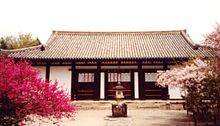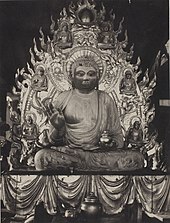Shin-Yakushi-ji
The Shin-Yakushi-ji ( Japanese 新 薬 師 寺 ) is a Buddhist temple of the Kegon school in Nara .
history
The temple was founded in 747 by the Empress Kōmyō , wife of the Emperor Shōmu , to pray for her husband, who had had eye disorders. The original complex consisted of a main hall, a teaching hall, an east and a west pagoda, but almost all buildings of the temple from the Tempyō period were destroyed by lightning strikes, typhoons and the devastation at the end of the Heian period . Only the main hall ( kondō ) remained and is therefore an important testimony to the architecture of the early Nara period .
In the Kamakura period , the priests Gedatsu ( 解脱 上人 ; 1155-1213) and Myōe ( 明 恵 上人 ; 1173-1232) added buildings, and the mother of the shogun Tokugawa Tsunayoshi , Keishō-in, contributed to the restoration of the statues at.
The buildings
(⦿ = national treasure , ◎ = important cultural asset of Japan )
- ⦿ Main hall ( 本 堂 , Kondō )
- ◎ Kannon Hall ( 観 音 堂 , Kannon-dō )
- ◎ Bell tower ( 鐘楼 , Shōrō )
- ◎ East Gate ( 東門 , Tōmon )
- ◎ South Gate ( 南門 , Nanmon )
Temple treasures
Main cult figure
- ⦿ Yakushi Nyorai , 8 books of ⦿Hokke sutras were discovered inside.
The twelve heavenly generals
A special treasure of the temple are the twelve heavenly generals ( 十二 神 将 , Jūni shinshō ). All figures have a supporting core, the surface of which is designed with clay ( 塑像 , sozō ). They are about 160 cm high, come from the Tempyō period except for the Edo period Haira and are registered as ⦿.
| No. | Japanese | Sanskrit | |
|---|---|---|---|
| Kanji | Surname | ||
| 1 | 伐 折 羅 | Basara | Vajra |
| 2 | 額 弥 羅 | Anira | Anila |
| 3 | 波夷羅 | Haira | Pāyila |
| 4th | 毘 羯 羅 | Bigyara | Vikarāla |
| 5 | 摩 虎 羅 | Makora | Mahoraga |
| 6th | 宮 毘羅 | Kubira | Kuṁbhīra |
| 7th | 招 杜羅 | Shōtora | Catura |
| 8th | 真 達羅 | Shintara | Kinnara |
| 9 | 珊 底 羅 | Santera | Śaṇṭhila |
| 10 | 迷 企 羅 | Meikira | Mekhila |
| 11 | 安 底 羅 | Antera | Antila |
| 12 | 因達羅 | Intara | Indra |
More treasures
From the Hakuhō period :
- ◎ Bronze yakushi, from the Heian period :
- ◎ Thousand-armed Kannon (wood),
- ◎ Fudōmyōō (wood) with two child companions.
Remarks
- ↑ This head appeared on a 500 yen postage stamp from the Japanese Post.
- ↑ Also known as Kubira: There are different assignments of names to the characters.
literature
- Folder of the temple.
- N. Nozawa (Ed.): Nara-ken no rekishi sampo (jo). Yamakawa Shuppan, 1997, ISBN 4-634-29290-4 , pp. 69-71.
Web links
- Temple website (Japanese)
Coordinates: 34 ° 40 ′ 33.1 ″ N , 135 ° 50 ′ 46.2 ″ E



